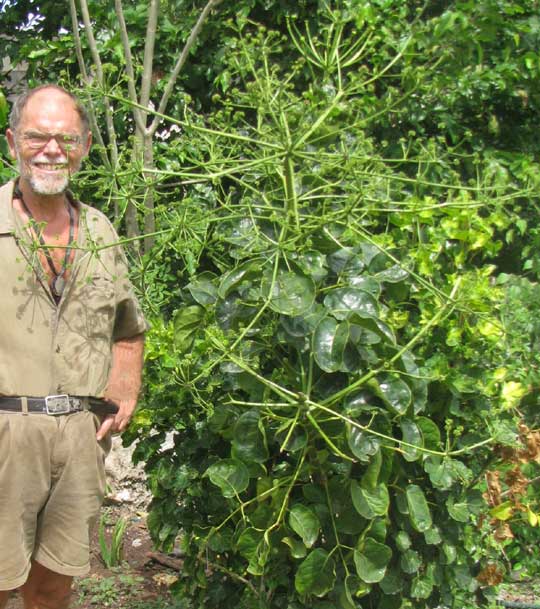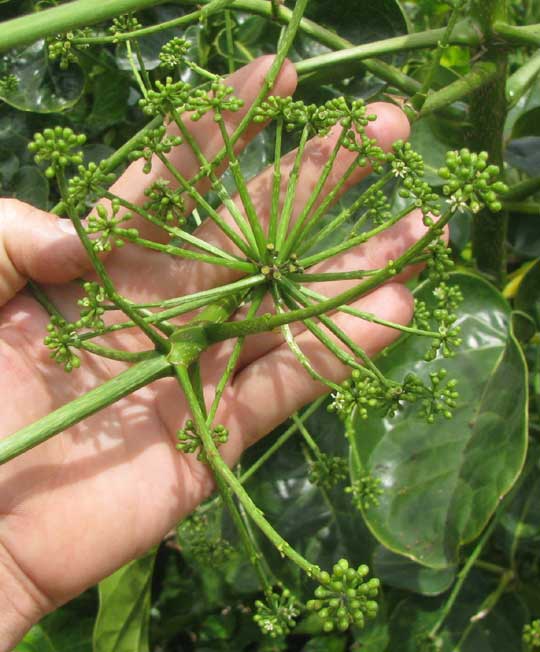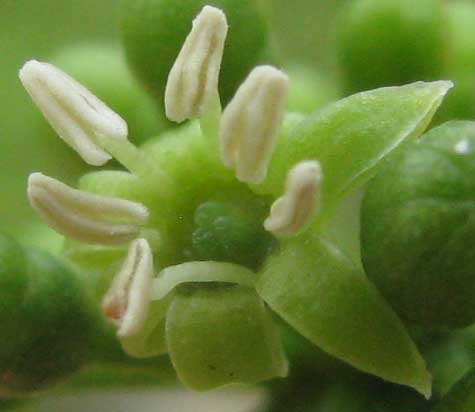Excerpts from Jim Conrad's
Naturalist Newsletter
from the March 4, 2012 Newsletter issued from Hacienda Chichen Resort beside Chichén Itzá Ruins; limestone bedrock; elevation ~39m (~128ft), N20.675°, W88.569°; central Yucatán state, MÉXICO
A RANGY, MYSTERIOUS GARDEN PLANT
Along one of Dzitas's little backstreets a bush with a grossly oversized flowering head showed up, as seen below:

Toward the bottom of that picture notice that at least some of the leaves are trifoliate -- compound, composed of three leaflets -- and that the leaflets are roundish on long stalks, or petiolules (leaf stalks are petioles, leaflet stalks are petiolules). Also notice that though the inflorescence was enormous for a plant of that size, the flowers were tiny and grouped in small, spherical heads, which in turn were clustered umbel-like at the end ends of sprawling stalks (rachillas), which themselves arise at the ends of long, flaring rachillas. The inflorescence must still be growing, for its tiny flowers only now are beginning to burst from their buds, as shown below:

A close-up of a single blossom is shown below:

So, what is this plant? I was standing scratching my head when I noticed the señora standing in her hut door looking at me smiling, so I laughed and called to her, asking if she knew a name for this strange plant. She came out followed by kids, wiping her wet hands on her dress, and with a serious look that suggested that she's often wondered the same thing, told me that she just didn't know. Neither did she know what it was good for or how it had found its way into her front yard.
Back in the hut, I had a hard time "doing the botany" because first off I made a mistake. Seeing the compound leaves and, more importantly, how its tiny flowers were grouped into umbels or umbel-like clusters (an umbel being a flower cluster with its flower pedicels arising from a common point, like the stays of an umbrella), I assumed that the plant was in the Parsley or Carrot Family, the Umbelliferae (now often known as the Apiaceae). However, after a lot of searching in that family nothing turned up like our mystery plant.
Then I remembered: In the past I've been fooled several times by plants in the Aralia or Ginseng Family, the Araliaceae, which is very closely related to the Parsley Family. The fruits of the two families are different, but we don't have fruits here. In general, however, species in the Aralia Family are more woody than those of the Parsley Family, plus flowers of the Aralia Family usually bear more than two styles, while flowers of the Parsley Family have only two. And in our flower picture you can barely see three styles atop the little green ovary in the blossom's center. So, we had an Aralia Family member here.
The Aralia Family is much smaller than the Parsley Family, which helped with the identification process. Members of the Aralia Family Northerners might be familiar with include Ginseng, English Ivy, Devils-Walking-Stick or Hercules Club and Spikenard. Our Dzitas plant is a member of the genus Polyscias, and if I had to bet I'd say it's POLYSCIAS SCUTELLARIA, which goes by several poorly established English names, including Round-leafed Polyscias, Shield Polyscias and Dinner-Plate Polyscias. It's native to the South Pacific.